DIGITAL DESIGN DIDACTICS
re-thinking design theory, methodology and pedagogy
by Rivka Oxman
Abstract
New media and digital techniques are now beginning to impact processes of design thinking and exploration. It enhances certain methodologies of formation, generation and performance-based design that were never before available in conventional, paper-based methods. Theories and methods of digital design can no longer be conceptualized as the merging of computational tools with conventional formulations of design. The assumption is that in the case of such a shift there is a need to re-consider the theoretical basis of current architectural discourse and its related body of knowledge, the new theoretical models of digital design in relation to the new media, methodologies and techniques. The paper introduces, discusses and presents a Digital Design Didactics framework as an integrated theoretical approach to new pedagogy and didactics. A new orientation to understanding the impact of digital media on digital design, linking design theory, methodology and pedagogy is presented discussed and demonstrated.
Introduction
Theories and methods of digital design can no longer be conceptualized as the merging of computational tools with conventional formulations of design. There is the need to pioneer a new understanding of the nature of designing in relation to digital design media. If the very nature of design is radically changing, how then can we accommodate and recognize emerging theories of design as the basis for a new pedagogy? It has now become important to consider the significance of terms such as design thinking and knowing (Cross, 2001) in relation to the digital media and what they might imply with respect to new approaches of design education and pedagogy. If digital design knowledge and processes constitute a new conceptualization, including concepts as the meaning of form, the nature of conceptual and formal knowledge (Oxman and Rotenstreich, 2005) in design, and generative and performative processes (Oxman, 2006), then there is a need for a new pedagogy. Furthermore, the evolution of digital design theory, the theoretical discourse and the representational capabilities of the new digital media are introducing today a new body of relevant knowledge and new concepts related to complex geometry, form, space, structure and material. As a result, new forms of architectural design and architectural production bring educators and encourage them to rethink traditional didactics, be experimental, test new pedagogical ideas and formulate new ways of teaching.
The conventional educational model in the design studio generally employs a simulation of praxis as a didactic model. That is, the didactic stages are driven by a theoretical interpretation of a program, a site and conditions carried through stages of conceptualization, schematic design and design development. Furthermore, most studios still employ well accepted knowledge-bases and typologies as well as traditional paper-based sketches and drawings as media of what was referred to as a conceptual and explorative medium. Schön's classic characterization of visual representation in design as a "conversation with materials conducted in the medium of drawing" (Schön and Wigging, 1992) and as a "backtalk" reflection on outcomes in paper based media such as sketches and drawings (Schön, 1985) still constitute the dominant model for teaching in the design studio. However, as we attempt to reevaluate the logic of the Schön model, we find the need to re-define the concept of representation and to understand the impact of digital design in design and design thinking. Furthermore, if indeed, contemporary phenomena of digital design are different from traditional models, then there is an emerging pressure to pioneer new teaching paradigms (Kvan et. al., 2004).
Within the framework of this orientation to a critical formulation of a new educational agenda, the following assumption is considered: in the case of such a shift in design there is a need to re-consider the theoretical basis, its related knowledge structures and design methodologies (Oxman, 2008a). In a period of such a shift there is a need to integrate theories of domain knowledge and theories of designing in order to address changes of both content and processes. Following this assumption, it has now become important to consider the significance of novel types of design knowledge in the digital design studio and their implications with respect to new approaches of new didactic principles for a new pedagogy.
Theoretical basis for a new ideology
With the evolution of digital design as a unique field of design endeavor, motivated by its own body of theoretical sources, and a culture of discourse, unique ideology, methodology and formal content are begining to evolve (Oxman and Rotenstreich, 2005; Oxman, 2006 ; Liu, 2005; Kolarevic, 2003). Given the growing amplitude of issues and subjects in digital design as witnessed by practice, research and education, we need to formulate a theoretical framework that is suitable to the formation of design educational theory.
The emergence of a new change and ideology
The awareness of change induced by conceptual conflicts between traditional and digital design are stimulating the need for a conceptualization of digital design foundations. Among these conceptual conflicts are encounters between certain root assumptions of modernist design and the contradictions that have emerged with digital design. Among these are the following:
-Digital design thinking is more than simply a set of formal preferences. It is the abandonment of the modernist design ontology that is predicated upon formal and typological knowledge (e.g. formal languages, typological classes and generic design, etc.) It is non-typological and non-deterministic in supporting and preferring the differentiated over the discrete and the typological.
-There is an emerging new symbiosis between the digital product of design and the way it is conceived, generated and produced in digital media. These stages are fundamentally different from those of modernist design. It is the understanding and formulation of this procedural symbiotic relationship between conception, generation, production and the product itself that appears to be of high priority today.
-Digital technologies appear to have freed the image from traditional concepts of representation. We no longer represent discrete shapes in the conventional paper-based sense. This condition has enhanced the denial of classical notions of representational conventions such as static space, and has introduced new concepts of dynamic and responsive space and form that are producing new classes of designs.
-In many cases approaches to form generation exploit emergence-based transformational processes in which digital media are the enabling environment. This in many ways is replacing the experimental visual nature of the paper-based sketching process.
-Context in the modernist sense may possess iconic, stylistic, or configurative content that can implicate design through visual or formal content. Context in digital design is considered a performative shaping force acting upon shape and form.
Models and methodologies of digital design
These indications of conceptual change have emerged in the formulation of design models, the conceptual content and vocabulary of digital design. A formulation through the identification of relevant early models of design has been developed by the author (Oxman, 2006). The classification of paradigmatic models include: traditional CAD models, formation models, generative models, performance models and integrated compound models. This classification enables the definition of underlying current digital design models and methodologies:
1.Traditional computation models
Early CAD models marked an attempt to depart from paper-based media. They had little qualitative effect on design in comparison to conventional paper-based models. In traditional CAD the interaction with formal representations supports the a posteriori automation of design drawings and visual models. First CAD systems were mainly descriptive, employing various geometrical modeling / rendering software.
2.Formation
In digital design the centrality of traditional concepts of paper-based representation is no longer valid for representing the thinking and processes associated with digital design. Furthermore, in certain formation processes of digital design the formal implications of the concept of representation are negative and unproductive. Emerging design theory has transformed the concept of form into the concept of formation associated with topological, parametric and animation. Topological design is based on the exploitation of topology and non-Euclidean geometry. Parametric design is based on principles of Generative Components (Burry and Murray, 1997). Animation, morphing and other range of motion and time-based modeling techniques are based on the propagation of multiple discrete instantiations in a dynamic continuum.
3.Generation
Generative models of digital design are characterized by the provision of computational mechanisms for formalized generation processes. Here, as compared to formation models, shapes and forms are considered to be a result of pre-formulated generative processes. Currently there is a rich theoretical body of research-related applications of generative models. Two main distinct current sub-approaches are shape grammars (Stiny, 1980; Knight and Stiny, 2001) and evolutionary models (Frazer, 2002).
4.Performance
Performance-based models are driven by performance and potentially integrated with formation and generative processes. Forces in a given context are fundamental to form-making in digital design. External forces may be considered as environmental forces including structural loads, acoustics, transportation, site, program etc. Information itself is also considered as an external “force” that can manipulate the design (Oxman, 2007).
From design content to didactic principles
We have attempted to build educational content by explicating the new conceptual structure of digital design knowledge and processes. In reality, the integration and interaction of technological content with that of conceptual content is obviously part of the formative process of learning to design with media. However, the exploitation and experimentation with new concepts can prove to be an articulate environment for design learning (Oxman, 2003) in which learning by making is transfigured by its conceptual, rather than computational, content. Given that a rigorous formulation of such emerging concepts does not yet exist, any work based upon a body of theory as yet unformulated must by necessity be experimental in itself. A logical first step to such exploratory work is to begin to sketch the outlines and principles of a theoretical order.
Beyond formal representations
The first stage of such a conceptual mapping is predicated upon the prevailing models of design at the level of their own conceptual structures. The prevailing model of modernist design is a formalist model in the profound sense of what we might term design ontology. Modernist design is formulated about the sequential development of symbolic representations of the design. It traditionally begins with considerations of space, with the major emphasis being upon the manipulation of visualizations of the design object – the design of form – through the stages of conceptual design, schematics, design development and materialization.
We are now moving beyond this formal syndrome. The parametric, topological, geometric and generative characteristics of current digital design (Lynn, 1999) are in profound theoretical contradiction to shape production in the formalist models. Irrespective of how unique that shape may be, it is still the process of shape production as the production of a static form. Digital design characterized by generative processes related to movement and time is neither formalistic nor static. Form generation, beyond formalism, produces conditions of pliancy and continuity in both the conception and geometry of form.
Formation, generation and performance: pedagogical implications
Formation, generation and performance are the motivating forces in the new design (Oxman 2008a). They, as concepts and processes, begin to condition new design procedures that are uniquely conceptual. To some extent, these conceptual stages – in the establishment of an appropriate morphology for the design – are also non-contextual. Shreds, Strands, Bleps, Flowers and Folds are among Lynn's (1999) interpretations of the morphologies of digital form.
It is this methodological sequence of dynamic procedures - formation, generative and/or performative that supports the preference for time-related or algorithmic computational media in place of paper-based design representations (Oxman, 2008a). This characterization of the digital design model is completely contradictory to models of design such as Schön's "reflective practitioner" in which the visual representation of the design is manipulated by visual reasoning through a succession of stages generally in the medium of sketching. This interpretation of sketching as design thinking through iterative stages of visual discovery is the antithesis of the digital model. Digital design brings the new design ontology beyond the visual interpretation of form.
The digital medium and the design process
A prime pedagogical goal is to define and explore the new understanding related to the impact of digital media through this concept of digital medium. One of the major aims in our studio was to demonstrate the methodological relevance of the concept of digital medium in relation to digital design processes. Furthermore, in the studio the need for the integration of both the digital model and the physical model were found to be extremely meaningful for the conceptualization of digital material. Since current descriptive geometrical modeling lacks material and structural logic, the physical model provides a complementary medium. The physical model is still very useful for feel and touch in exploring principles of form, morphology and structure. Physical studies can then be translated into digital models for transformation and versioning.
Re-thinking digital design principles
The experimental digital design studio is part of a larger educational project built around the Digital Design Research Group (DDRG) at the Faculty of Architecture and Town Planning. It includes a group of researchers carrying on work in various aspects of digital media research; a program of graduate studies and graduate research leading to the M.Sc. and Ph.D. degrees and including the production of theses; a series of theoretical and methodological courses generally operating as graduate studies open to undergraduates; and an undergraduate design studio for digital design called the Experimental Digital Design Studio.
In the following section a didactic approach in guiding different paradigmatic projects is presented and illustrated. Each project was developed by exploiting digital concepts and techniques that suited the theoretical and conceptual content of the project. Each conceptual basis presented the designer with a medium for the development of the material concept through its parametric and morphological evolution. In each of the following selected projects a conceptualization of digital material and a unique digital process appropriate to the material concept and to the type of media is presented.
Our didactic process consists of the following four basic tasks: the first task is to conceptualize and test a generic type of digital material. The second task is to define a unique responsive strategy for modification. The third task is to select a distinct digital model. The fourth task is to select a context that can best demonstrate the behavior and applicability of the design material in relation to task specifications. In the following sections we demonstrate and illustrate these didactic steps in a series of selected projects. A wider range can be found in Oxman, 2008a.
Experimenting with digital forms
The first project is termed: "The Boundary Wall”. The specific context is related to a design program dealing with site conditions, programmatic aspects and constraints which vary along the length of a boundary line. The design medium in this project attempts to apply topology that maintains the same relations along the border line. It accommodates the new complexity of a certain topology (Emmer, 2005), departing from the more static and typologically deterministic logic and design methodologies of the previous generation (see figure 1.1). The changing requirements found along the boundary create a constantly changing condition of context and program along the otherwise continuous design of the boundary. Together, the performance-based approach and the definition of parameters produce differentiation and heterogeneity (see figure 1.2) in the design rather than the instantiation of a particular style, or standardized, modular structure as is currently routinely applied irrespective of complex changes of program and conditions . This approach relates to the generic problem of complex program and changing conditions.
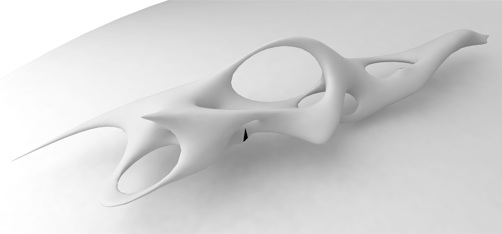
Fig. 1.1
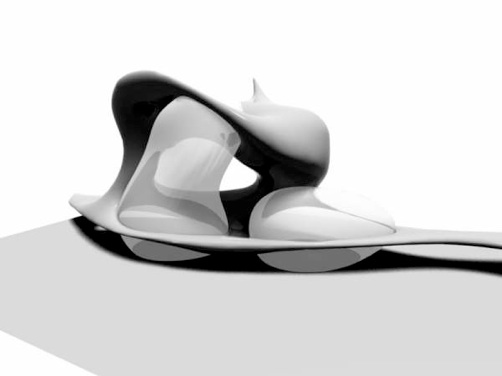
Fig. 1.2
Fig. 1. "The Boundry Wall": a topological design of a continuously evolving boundry wall (by Farah Farah, Technion)
Experimenting with parametric design
The next project is termed: "The Structural Tower”. In this project, the reconsideration of topology and non-Euclidean geometry as a methodological basis for digital design has contributed to the exploration of new geometrical possibilities. Within this emerging context of computational geometry in architectural design, parametric and associative geometrical models are powerful tools for design. In such a context, the effect of digital environments enables the reconfiguration of parameters of the structural morphology.
In this project the digital medium has been defined as a structural morphological system of parametric modules (see figure 2.1; 2.2). The design process resulted in the production of parametric differentiation of a continuous system.
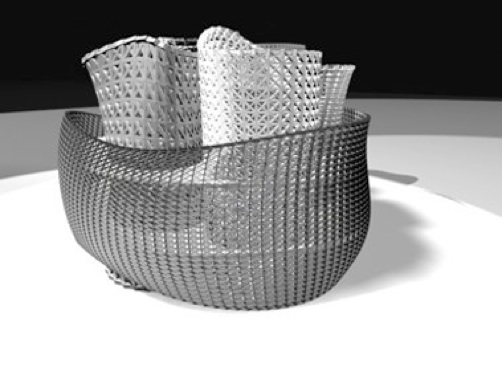
Fig. 2.1
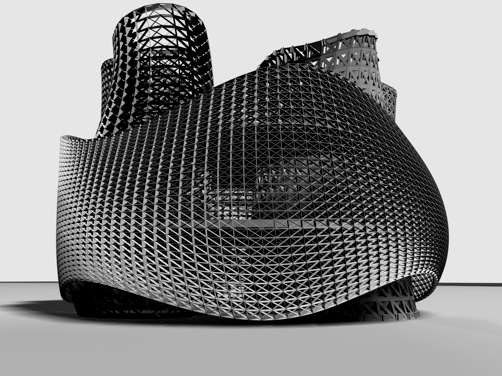
Fig. 2.2
Fig. 2. "The Structural Tower" a Parametric design of structural morphological system of parametric components (by Shoham Ben Ari, Technion)
Experimenting with generative and formation principles
The third project was a "Sun-Shed" termed “Textlight mechanism”.The conceptualization of the digital material is based on morphological principles of woven textiles. This woven material created an indeterminate range of heterogeneous folded profiles that were versions of folding and weaving principles. These profiles evolved to enable spatial, structural and environmental envelope functions within the woven matrix (see figure 3.1). The design transformations are defined by a set of rules Generative and formation principles were defined as a set of transformational rules which reflect knowledge enbedded in a folded profile (see figure 3.2). In this case the rotation of the folds were calculated in response to light condition
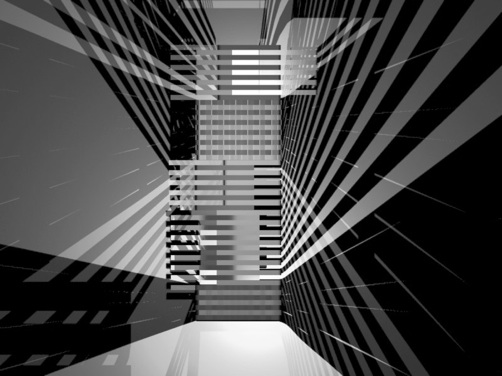
Fig. 3.1

Fig. 3.2
Fig. 3. "The Sun Shed": a generative system based on morphological principles (by Alex Eitan and Tal Kasten, Technion)
Experimenting with performance-based design
This forth project is termed "The Responsive Wall". This project might protect a building from excessive wind loads, solar penetration and acoustical contextual problems such as urban noise. The responsive wall is a project that integrates a constructive skeleton that supports a dynamic surface structure (see figure 4.1). The skeleton has built-in sensors that can inform and simulate the dynamic motion of the skin which is designed as a system of scales (see figure 4.2).
The skin design itself has been generated by a performative simulation of wind force and light penetration. These forces produce dynamic effects on the skin. Animated techniques were employed to produce these dynamic simulations and performative effects. The objective in this model was that the formation of the skin/structure assembly will be generated by multiple performative conditions, all of which are dynamic.
Instead of treating design as the composition of a static form, animation was employed as a simulation of dynamic forces in order to generate the design (Oxman, 2008b). We have exploited animation to study the motion of a complex surface-skin. Animated techniques in 3d MAX were employed to model simulation processes and their dynamic effects. In order to study the dynamic motion of the surface we selected wind force as a case study. Simulation of the dynamic factors and their effects on the surface were formulated by using reactors in 3DMax. The physical attributes of the surface were set up by specifying a reactor for the surface-skin. The second reactor in this experiment was a ‘Reactor-Wind’. Both supported the cloth simulation and the physical behavior of wind.
The physical parameters of the surface were set up by specifying physical parameters of the surface such as: mass, density elasticity, stiffness, stretching and damping. They were defined in order to simulate the dynamic environment. Wind simulation, in fact, generated the shape of the surface-skin.
The second performance factor was light. The lighting condition below the surface-skin was a result of reaction to the wind causing the opening or closing of scales (see figure 4.2). At this stage they enabled visual evaluation in order to study the impact of skin geometry and scale position on light penetration.
To conclude - in this experiment force simulation and motion were employed to generate a form. The animation produced transformation of the complex surface and the form of the surface was, in fact, the result of a dynamic force. In this case, the design objective is to support the dynamic behaviour in the various components in response to the dynamic nature of the wind and light loadings of the building surface. In a future development of an advanced system we hope to achieve modifications that will be driven automatically by the performance model.
This condition of design models, that support multiple performative analyses in their assembly of components, is highly representative of complex wall assemblies. In this case, the design objective was to support the dynamic behaviour in the various components in response to the dynamic nature of the wind and light loadings of the building surface. Animation studies were employed to model the formation process in which form generation was controlled according to types of simulations.
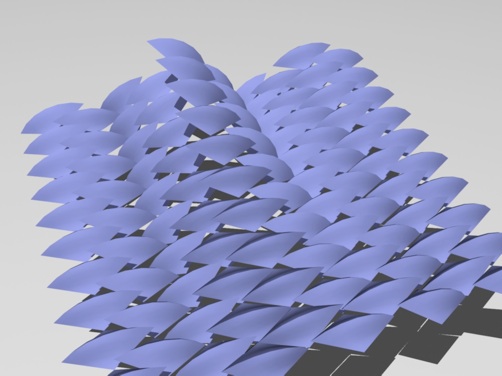
Fig. 4.1
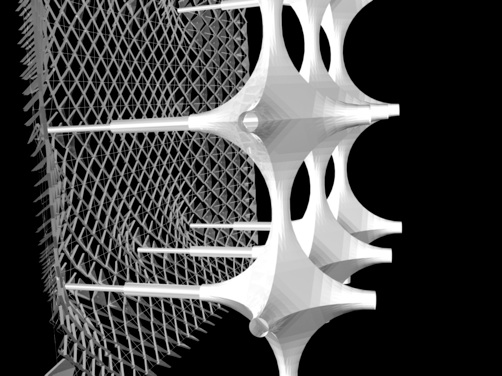
Fig. 4.2
Fig. 4. "The responsive Wall": employing animation as a simulation process in performance-based design (by Shoham Ben Ari and Roey Hammer, Technion)
Summary and conclusions
Our experimental teaching is based on the integration of a theoretical module and an experimental module, both carried out in the framework of an experimental digital design studio.
The theoretical module emphasizes the departure from paper-based design concepts and sketch-based design that is based on visual representation and modification of images in design. We define the transformation of root concepts in design theory such as representation, typologies, and other principles of the visual literacy school of design pedagogy which is related to paper-based media (Schön, 1985). New body of concepts such as hyper-continuities; connectivity and differentiation; morphogenesis, generative and performance-based design; materialization and production; etc. are introduced as a new theoretical basis. These are defined as a set of concepts deriving from the synergy of the digital technologies and the new theoretical discourse.
The second module is an experimental studio that is conceived of as the exploration of design research in digital design. It emphasizes digital design as a form of integrating a theoretical architectural content and a design method. The designation of the studio as an “experimental design studio” serves to free the student from expectations related to conventional processes involving functional programs, the conventionalized design sequence from concept, to space, to project representation, etc.
The process is not “project-oriented” in the conventional understanding of the term. No program or specific site is presented at the inception of design. So this is not a conventional model of design from problem to solution. Once a generic system or a formal structure has been developed for research (see figures below), there is a need to demonstrate the functional potential and applicability of this system/formal structure.
The exploration of models and their transformative potential becomes a focus of the search for a dynamic design medium. Rather than a conventional programmatic orientation of the studio, the experimentation is based upon the search for a structural mechanism-frequently a morphological, cellular, or a spatial, structural mechanism- that supports a potential for differentiation in response to performance requirements. The structural qualities of repetitive assemblies are experimented and their ability to react and respond to local forces through deformations and geometric transformations is explored. For example, such “natural responses” are viewed as attributes of the structure.
Given that the orientation presented in this paper, is towards exploration and research rather than the production of a final product in the form of a one-off finished design, each student can be assigned a research task appropriate to his own interests and aptitudes. All work is in the form of multiple short design experiments which are finally produced by each student as a research report.
Acknowledgement
This chapter presents the work of the Digital Design Experimental Research Group in years 2006/07 at the Faculty of Architecture and T.P. at the Technion, Israel. My students, Farah Farah; Tal Kesten, Alex Eitan, Shoham Ben Ari and Roey Hamer are acknowledged for their contributions. This workwas presented in the ENHSA-EAAE internatiuonal symposium hosted by the school of architecture, University Lusiada, Lisbon, Portugal, May, 2007
References
Burry, M., & Murray, Z.: 1997, Architectural design based on parametric variation and associative geometry Challenges of the future, ECAADE conference proceedings, Vienna, Austria
Cross N.: 2001, Designerly ways of knowing; design discipline vs. design science’, Design Studies vol. 17, no. 3 pp: 49-55
Emmer, M.: 2005, Mathland: the role of mathematics in virtual architecture, in Nexus Network Journal, Birkhauser, Basel, Vol. 7 No. 2 pp. 73-88
Frazer, J. H.: 2002, Creative design and the generative evolutionary paradigm, in Bentley and Come, pp. 253-274
Knight, T., and Stiny G.: 2001, Classical and non-classical computation, in ARQ: Architectural Research Quarterly, Vol. 5 pp. 355-372
Kolarevic B.: 2003, Digital morphogenesis, in Architecture in the Digital Age, in B. Kolarevic, (ed), Architecture in the Digital Age, Spon Press, New York
Kvan T., Mark, E. Oxman R. E. and Martens, B.: 2004, Ditching the Dinosaur: Redefining the Role of Digital Media in Education, in International Journal of Design Computing, No.5, MIT Press, Cambridge
Liu, Y.T (ed.): 2005 Demonstrating Digital Architecture, Birkhäuser, Bern
Lynn, G.: 1999, Animate Form Princeton Architectural Press, New York
Oxman R.: 2003, Think-maps: teaching design thinking in design education, in Design Studies, Vol. 25 No. 1 pp. 63-91
Oxman, R., and Rotenstreich R.: 2005 Conceptual content of digital design: the quest for new paradigms, in 23rd eCAADe Conference Proceeding, Lisbon Portugal, pp 115–121.
Oxman, R.: 2006, Theory and design in the first digital age in R.Oxman (ed), a special issue on Digital Design, Design Studies, Elsevier, Vol 27 No 3.
Oxman, R.: 2007, New media-new didactics, in ENHSA-EAAE International Symposium on Teaching and Experimenting with Architectural Design, Lisbon, Porugal
Oxman, R.: 2008a, Digital architecture as a challenge for design pedagogy: theory, knowledge, models and medium, in Design Studies, Vol. 29 No. 2, pp.99-120,
Oxman, R.: 2008b, Perfomance-based design: current practices and research issues, in International Journal of Architectural Computing, IJAC, Vol. 06 No. 1, pp. 1-17
Schön, D., A.: 1985, The design studion: an exploration of its traditions and potentials, RIBA Publications
Schön, D. A and Wigging G.: 1992, Kinds of seeing and their functions in designing, in Design Studies Vol. 13 No. 2 135-156
Stiny, G.: 1980, Kindergarten grammars: designing with Froebel's gifts in Environment and Planning B: Planning and Design Vol 7 pp. 409–462.